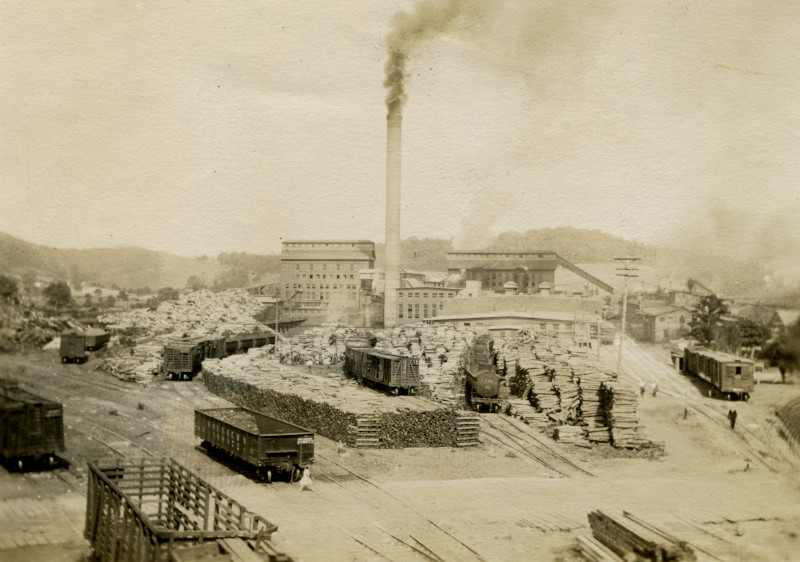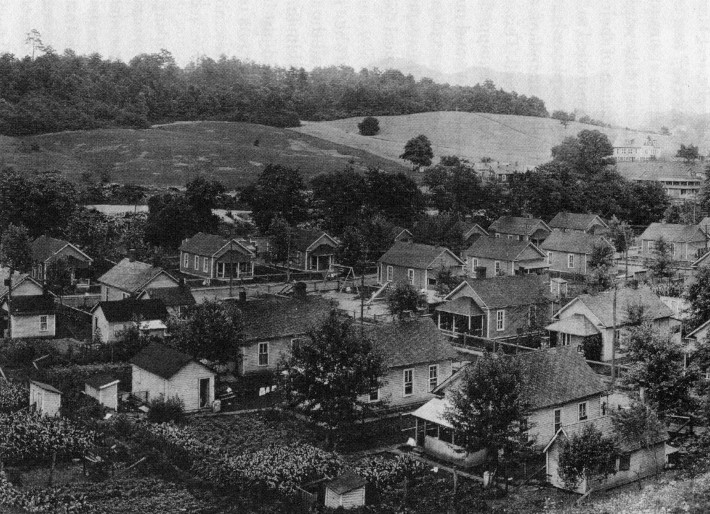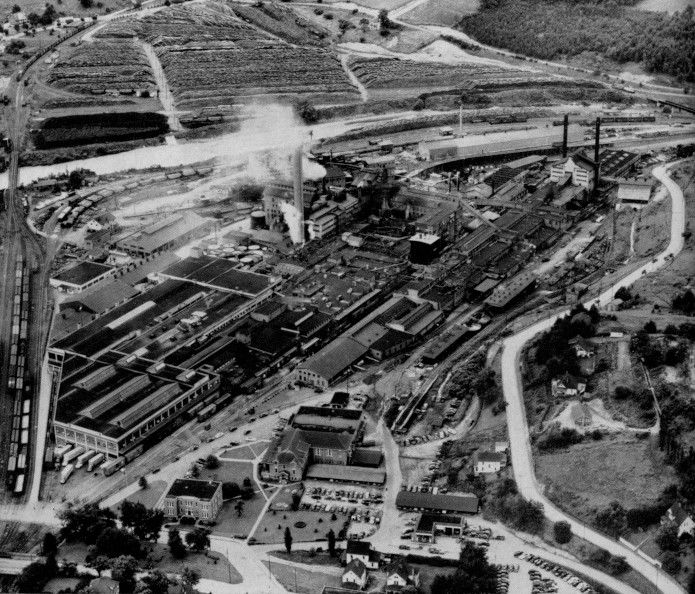Nestled in the heart of the North Carolina mountains, less than 20 miles west of Asheville, lies Canton, a small Appalachian town rich with the history of a hard-working people, of families tightly-knit through generations. Many of these families, and certainly the community, are woven together by the Canton paper mill, which during its 115-year history has been the lifeblood of the local economy and the fabric of its residents’ lives.
Canton is a picturesque mountain town. Nineteenth and 20th-century homes dot the hillsides. The Pigeon River flows through the burgeoning downtown area on its way to Tennessee. Standing on the sidewalks alongside the brewing company or the mercantile, the candle shop or the cafe, it’s easy to see the charm the town exudes.
Look up and you’ll see the mill, the centerpiece of the community, located on about 200 acres in the downtown area. In 1905, when the mill site was purchased and construction broke ground, Canton had hardly more than 200 residents. Three years later in 1908, the mill opened as Champion Fibre Company.

Where It All Began
In 1893, 15 years before the Canton paper mill opened its doors, Champion Coated Paper Company was founded in Cincinnati by Peter G. Thomson. A publisher by trade, Thomson knew change was in the air in the world of printing, and he was going to be at the forefront of it. Specifically, smoother paper than that which was readily available was in increasing demand. Thomson responded to this need by opening his first paper plant in Hamilton, Ohio. He sourced his pulp from places like New York, Pennsylvania, and West Virginia.
As the business grew and industry demand increased, Thomson began to explore the purchase of his own pulp mill in order to bring his pulp source in-house. And so along with his 1905 purchase of the Canton mill site, Thomson purchased 25,000 acres of spruce forest in what is now Pisgah National Forest. In addition to easy access to timber as well as water from the Pigeon River, the straight railway route from Canton to Hamilton made the small mountain town an ideal choice for the mill. But in the end, it was the heart and work ethic of Canton’s people that became the business’s boon.
A Mill Town is Born
After the construction of the Canton Paper Mill, Champion built 60 small dwellings for a number of mill workers and their families. The cluster of homes became known as Fibreville. This, perhaps, was the start of the mill beginning to beat as the pulse of the mountain town. Spurred by demand for mill workers, the population of Canton grew from 230 residents in 1900 to 1,393 in 1910.

Innovation in the World of Paper
When Thomson completed construction of the mill in 1908, he turned its operation over to his son-in-law, Reuben Robertson. Robinson is known for leading the mill through some of its most innovative and successful years, serving as a pioneer of processes that became crucial to the papermaking industry throughout the world. Champion was the first in the world to make white pulp from chestnut wood. It was the first paper mill in the South to make spruce sulfite, the dark, syrup-colored tree extract used to tan leather. And Champion also spearheaded one of the first research divisions in the industry, which dramatically improved quality and cost in papermaking. Thanks to his innovation and leadership, Robertson earned the nickname Mr. Champion.
Strength Through the Great Depression
In 1922, growth continued for the paper mill when the mill installed the first book paper mill in the Southeast United States. Six years later, in 1928, the Champion Papers knight logo was created.

On the heels of the stock market crash of 1929 and the beginning of the Great Depression, the mill’s founder Peter G. Thomson, died. Champion Fibre Company made a decision that not only helped create Great Smoky Mountains National Park but also sustained the company through the Great Depression: they sold 90,000 acres of the land they’d used to harvest timber to the US government. This land eventually became part of the national park, and the $3 million sale price allowed the Canton mill to purchase new equipment, including the world’s largest book paper machine at that time, and kept the company afloat.
In fact, as many industries suffered through the Great Depression, paper (as well as tobacco products and some chemicals) saw impressive industry gains during a decade otherwise wrought with economic hardship. Paper plants had begun to find a new use for paper – for packaging – which increased demand for the product.
In 1934, the mill began to produce high-quality white pulp from southern pine, the very first paper mill to do so. This was made possible by a multi-stage bleachery, and eventually led to Canton being the first US mill to manufacture bleached hardwood pulp cooked by a sulfate process.

A Mid-Century Mainstay
From its inception through the mid-1900s, the mill was a booming operation. The 1940s continued to bring growth to the Canton paper mill, this time with new and improved equipment. The mill could now print paper suitable for magazines, and also introduced an even larger book paper machine. By the 1950s, the Canton mill housed the world’s largest machines for making white paper.

Change is in the Air
By 1992, there were 1,714 employees at the Canton paper mill and 251 workers at its Waynesville, North Carolina conversion facility. During this time, the Canton mill was a major paper producer for Life magazine. Just several years later in 1999, the employees of the Canton operation purchased the mill from Champion Coated Paper Company in a $200 million buyout led by the workers’ union. They renamed the company Blue Ridge Paper, which continued on as a significant regional producer of envelope, writing, and print papers, as well as packaging products. In 2006, the mill transferred ownership again and is renamed Evergreen Packaging.
The End of an Era
In March 2023, Evergreen Packaging announced its plans to close the Canton paper mill in June of the same year. More than 1,000 people will lose their jobs. A number like 1,000 carries weight, but it runs the risk of reducing the families and individuals impacted by the closing to merely a number. Yet each of these more than 1,000 has a face, has a name – most of them have the mill in their blood, the mill having been an intergenerational place of work for their families.
A man recounts stories of his grandfather and great grandfather working in the mill. Two brothers rely on their mill income to put food on both their families’ tables. At a family reunion, uncles and cousins share barbecue and blessings, knowing that soon they won’t be walking together through the door to the paper mill any longer.
Canton built a legacy as one of the premier US mill towns, and the closure of the mill will be an ending to the great saga of Champion paper and the Canton paper mill. Our hearts go out to the Canton mill workers, their families and residents of the region — all of whom will face difficult, uncertain futures due to the closure.
Note: The paper mill currently handles wastewater treatment for the town of Canton, and plans for the continued service of wastewater are being made.
Effects on the Pigeon River, Past and Future
In the 1980s and ‘90s, a simple glance at the Pigeon River was enough to reveal its polluted state. The river channel, almost devoid of fish, was filled with jet-black water, serving as a stark reminder of the cost of upstream economic security. However, there was a significant improvement over time, with the most rapid water quality improvements occurring between 1997 and 2001 following requirements stemming from a settlement agreement in December 1997. The mill’s 1996 wastewater discharge permit had been contested by various water quality groups and the state of Tennessee, leading to requirements that made a substantial difference in just three years. Subsequently, the 2011 permit process also brought about some improvements in water temperature.
Despite ongoing debate regarding the dye’s impact on water quality, the impact of temperature is well-documented. Evergreen releases warmer water back into the river, which poses a problem for species adapted to cool mountain streams. Cooler water downstream would result in more aquatic diversity, providing an encouraging sign for the future of the river’s ecology.
The Pigeon River, being a small river, was highly sensitive to any discharge from the mill, making its pollution a significant concern for decades. Nonetheless, the improving downstream water quality offers a welcome silver lining to this once-clouded story. As Canton writes the next chapter of its ongoing comeback story, a clean-flowing Pigeon River could prove to be a vital asset.

Papertown Lives On
Perhaps the Mayor of Canton, Zeb Smathers, says it best:
I’m ready to fight to make sure that this is not the end of Canton, but the next chapter of our comeback story. I am ready to speak to say it is past time that rural Americans, and blue collar workers, and small towns are given equal respect and dignity. I am ready for the next steps, but know we are not going anywhere.
I am blessed to forever call Canton home and my neighbors, in good times and bad, friends. God Speed Papertown and Go Bears!”
A Personal Note from Bradley Pace
Altamont Property Group’s Bradley Pace speaks on a personal note about the Canton paper mill’s impact on his family:
My father and brother were both long-time employees of the mill, with my father joining the maintenance department in January 1992 and my brother starting in production in January 2004 before later joining the maintenance department in 2005.
During their time at the mill, they formed lasting bonds with their colleagues and took pride in their work, serving various roles and even becoming members of the Emergency Response Team. One of the most meaningful experiences for them was participating in the Christmas Baskets program, which provided food baskets to those in need during the holidays, as well as the Santa Pal program, which supplied clothing to children in need.
As a family, we were grateful for the opportunities that my father’s job at the mill provided for us, even though I myself never stepped foot inside the facility. The overtime hours he worked helped us play sports, attend college, and meet our everyday needs and wants. There are so many memories and traditions I will carry on and remember from my childhood through my later years.
So many local families have stories similar to ours. You will not find many folks in Canton and Haywood County who do not have some type of connection to the paper mill. While the paper mill may be shutting its doors, one thing is for sure — the Town of Canton isn’t going anywhere. The people of Canton, as they always do, will rally around one another and keep moving forward. They have been put to the test time and time again and always respond with resilience and grit. In the famous words from Balsam Range, “This ain’t just another papertown, it’s the one that I call home.”
Contact Bradley:
bradleypace@kw.com
828-782-5582

